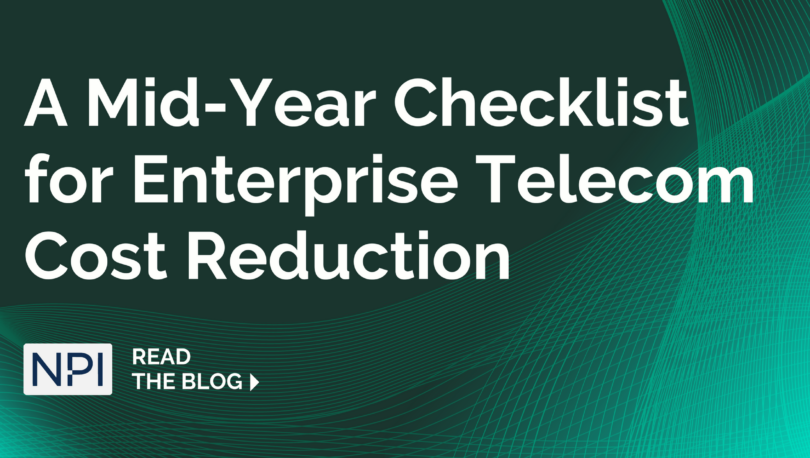As we approach the mid-year mark, many procurement leaders have been tasked with getting rid of cost waste across the IT ecosystem. This is not a byproduct of any sort of widespread slashing of enterprise IT budgets (most enterprises will spend more, not less, in 2023). Rather, it’s a cautious response to the current business climate, and a doubling-down on good IT budget hygiene.
The challenge for many IT procurement practitioners is where to begin. After all, there are a million ways to cut IT costs. Our advice is to focus on areas that have the potential to deliver the most immediate and material savings with the least amount of disruption.
One of those areas is telecom. Inspection of enterprise telecom costs almost always reveals significant, unintentional overspending. This can be surprising to those enterprises that have already invested in telecom expense management tools. It’s not that these solutions are ineffective; it’s that they primarily focus on spend visibility – and that’s only one element of telecom spend management.
Meaningful enterprise telecom cost reduction requires getting to the root of the problem, which requires continuous usage/plan alignment as well as understanding where (and how) carriers are extracting unplanned revenues. Also important is optimizing usage and cost at a regular cadence.
The good news is telecom cost reduction and remediation can be relatively painless when aided by the right resources. Here is a checklist of things you can do right now to eliminate wireless and wireline overspending for the remainder of the year (and beyond):
If you haven’t optimized your telecom carrier agreement in the last 18 months, it’s time.
This is ground zero for savings – 15% to 30% in most cases. That’s particularly true for customers that haven’t optimized their carrier agreements in the last couple of years, have grown or contracted significantly, or have satisfied their minimal annual revenue commitments. Four key questions to ask during carrier contract optimization are: Have we benchmarked pricing/rates to ensure we’re getting the best deal? Are we receiving best-in-class discounts and credits based on current and historical spend volume? Are contract terms and conditions world-class? Are there penalties or fees that we can negotiate down or out of our agreement (such as early termination fees)? And don’t forget reviewing cost-related terms in your contracts (e.g. rebates, credit incentives, discounts) to make sure your carrier is in compliance.
If you have more than 5,000 subscribers, review usage and adjust subscriptions.
If your usage doesn’t align with the right service/subscription, you’re probably overpaying. Best practice is to conduct a review of actual and forecasted usage, then align to best-fit service options. This helps you accomplish two things: (1) determine usage profile of individual users, and (2) groom your telecom estate for zero-use lines and underutilized services. Both can have a powerful impact on telecom costs (an average of 10% to 25%). Once you complete a baseline review, consider ongoing hygiene options such as outsourcing to a telecom expense management service.
Review and rebalance cellular data usage.
As we shared in this post a while back, the easiest way to look for cellular data usage is to download a PDF copy of your bill and review the first few summary pages. Look for usage charges or activity since last bill. These charges typically cover equipment purchases (buying a new phone), roaming charges (International), or excess usage (voice minutes, messaging, or data). Since most current plans have unlimited voice and messaging, charges are most likely due to using more data than is in the data pool. This can be remedied by re-balancing the data pool with a different subscription mix.
Prioritize telecom invoice auditing to identify and remediate billing errors.
Billing errors are surprisingly common, which is why companies should review them regularly. Be sure to review your bills through two distinct lenses. The first is making sure the carrier/provider is adhering to contractual pricing. The second is making sure they’re adhering to discounts and incentives covered in your agreement.
Prepare for spike in T1 Pricing.
This is specific to enterprise AT&T customers that have a renewal coming up in the next 6 months. If you have T1 or NxT1 access lines in your network, you can expect to see price increases of 150% to 300% or more. If you’re negotiating a more forgiving on-ramp to these higher costs, expect a very short grace period, if any. If AT&T extends the current contracted rate, it will only be for six months before the first increase. The best course of action is to immediately begin technology transformation projects that will migrate T1 access to cable or fiber optic media. If your current AT&T agreement doesn’t expire for a while, be sure to secure competitive T1 pricing from AT&T now so you are paying the best price possible while you strategize and execute a transition to other services.
Remember, it’s possible to make a material reduction to your telecom spend in 2023. The key is getting started. If you don’t have the expertise and resources to devote to telecom cost optimization internally, it can be easily outsourced to experts with deep knowledge of carrier contract and service optimization.
Interested in learning more about how to easily reduce telecom costs? NPI’s telecom cost optimization experts can help. Contact us.
RELATED CONTENT
- Blog: To Achieve Telecom Cost Reduction, Inspect Usage Charges in These Areas
- Blog: 6 Hidden Telecom Costs Exhausting Your IT Budget
- Bulletin: How to Negotiate Savings with Verizon Wireless
- Bulletin: Which Telecom Cost Control Tactics Yield the Biggest Savings?
- NPI Service: Telecom Cost Optimization Consulting
